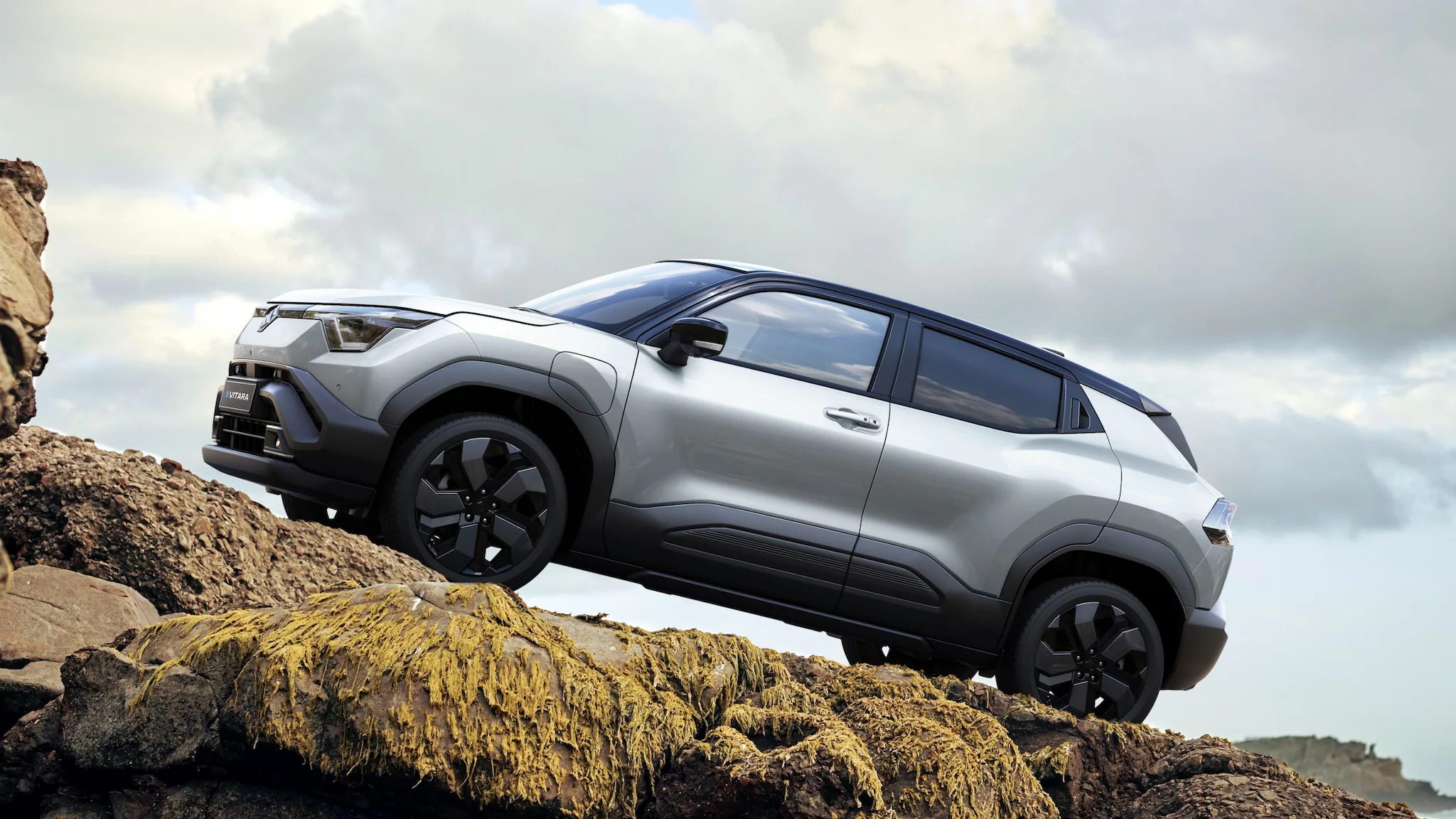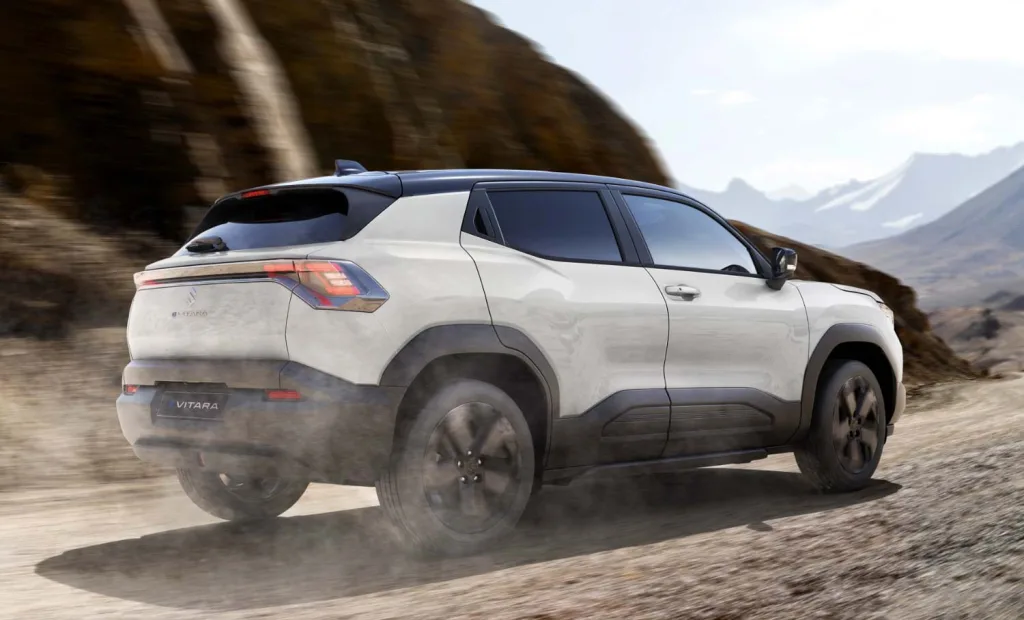
In the evolving landscape of India’s automotive industry, the Maruti Suzuki e-Vitara stands as more than just another electric vehicle launch. It represents a watershed moment for both the country’s largest carmaker and the nation’s electric mobility aspirations. As Maruti Suzuki’s first fully electric SUV, the e-Vitara isn’t merely a new product—it’s a statement of intent that signals India’s readiness to embrace an electric future.
The Maruti Suzuki e-Vitara represents a significant milestone in India’s electric vehicle journey. With its planned early 2025 launch, this electric SUV carries the weight of expectations from consumers, industry watchers, and policymakers alike. But what makes this particular vehicle so important for both the company and the country? Let’s dive deeper into why the e-Vitara could be the catalyst that transforms India’s EV landscape.

Contents
- 1 Technical Prowess: What Powers the e-Vitara
- 2 Design and Features: Beyond the Electric Powertrain
- 3 Maruti Suzuki e-Vitara Price: Strategic Positioning
- 4 The Maruti Suzuki e-Vitara Launch: Timing and Strategy
- 5 Beyond Domestic Markets: The Export Strategy
- 6 The Maruti Suzuki e-Vitara Significance for India
- 7 Looking Ahead: What the e-Vitara Means for the Future
- 8 FAQs About the Maruti Suzuki e-Vitara
- 9 Conclusion: A New Chapter for Indian Mobility
Technical Prowess: What Powers the e-Vitara
The e-Vitara isn’t just Maruti’s first electric SUV—it’s a technological showcase built on the company’s innovative HEARTECT-e platform, specifically engineered for electric vehicles. This purpose-built foundation allows for optimal battery placement, weight distribution, and structural integrity.
Under the hood—or rather, under the floor—the e-Vitara comes with two battery options to cater to different range requirements and budgets:
| Battery Variant | Power Output | Torque | Estimated Range |
|---|---|---|---|
| 48.8 kWh | 142 bhp | 192.5 Nm | ~350-400 km |
| 61 kWh | 172 bhp | 192.5 Nm | Up to 500 km |
What’s particularly impressive is the battery system’s resilience. Incorporating 120 lithium-ion cells, it maintains optimal performance across an extraordinary temperature range of -30°C to 60°C—a crucial feature for India’s diverse climate conditions from the Himalayan regions to the scorching plains.
The e-Vitara’s initial launch will feature a Front-Wheel Drive (FWD) configuration, though industry insiders suggest that All-Wheel Drive variants might follow based on market response. With a maximum driving range of 500 kilometers on a single charge, the e-Vitara directly addresses one of the primary concerns for potential EV buyers: range anxiety.
Design and Features: Beyond the Electric Powertrain
Safety features in the e-Vitara include ADAS Level 2 technology with over 15 advanced driver assistance systems. This marks a significant step up for the Indian market, where such advanced safety features are still relatively uncommon in mass-market vehicles.
The exterior design follows what Maruti calls a “Polyhedral Muscular Stance,” featuring:
- R18 aerodynamic alloy wheels
- NEXTrè 3-Point Matrix LED DRLs
- Streamlined body shape for improved efficiency
- Distinctive front fascia that signals its electric identity
Inside, the e-Vitara offers a premium experience with:
- 26.04 cm multi-information display
- Digital cockpit experience
- Ventilated front seats
- 10-way power adjustable driver’s seat
- Sliding and reclining rear seats
- Sunroof with fixed glass
- Wireless charging capability
These features position the e-Vitara as a premium offering within Maruti’s lineup, targeting a more affluent segment than their typical mass-market vehicles.
Maruti Suzuki e-Vitara Price: Strategic Positioning
The Maruti Suzuki e-Vitara price is expected to range between ₹20-25 lakh, making it competitive in the premium EV segment. This pricing strategy places it in direct competition with:
| Competitor | Price Range (Est.) | Launch Timeline |
|---|---|---|
| Mahindra BE 6 | ₹20-25 lakh | Mid-2025 |
| Tata Curvv EV | ₹18-23 lakh | Late 2024 |
| MG ZS EV | ₹23-27 lakh | Already available |
| Hyundai Creta EV | ₹20-25 lakh | January 2025 |
The strategic Maruti Suzuki e-Vitara price positioning will be crucial for its market success against established competitors. While not the most affordable EV option, it represents Maruti’s entry point into the premium electric segment, with the company likely to introduce more affordable electric models in the future.
Available in three variants—Delta, Zeta, and Alpha—the e-Vitara will offer different levels of equipment and features to cater to various customer preferences and budgets.
The Maruti Suzuki e-Vitara Launch: Timing and Strategy
The Maruti Suzuki e-Vitara launch is scheduled for early 2025, with production already underway at the company’s Gujarat facility. This timing is strategic, coinciding with:
- Increasing government push for EV adoption
- Growing charging infrastructure across urban centers
- Rising consumer awareness and acceptance of electric vehicles
- Entry of multiple competitors in the electric SUV segment
Preparations for the Maruti Suzuki e-Vitara launch include expanding the charging infrastructure across NEXA dealerships nationwide. This network approach leverages Maruti’s extensive dealer presence—a significant advantage over newer entrants in the EV space.
Industry analysts consider the Maruti Suzuki e-Vitara launch a watershed moment for India’s EV ecosystem. As the country’s largest carmaker embraces electric mobility, it signals a tipping point for mainstream adoption.
Beyond Domestic Markets: The Export Strategy
What makes the e-Vitara particularly significant is Maruti Suzuki’s ambitious export plans:
- Target of 5,000-6,000 monthly EV exports
- Distribution to over 100 countries
- Key markets include Japan and Europe
This export-oriented approach positions India as a manufacturing hub for global markets, enhancing the country’s status in the international automotive ecosystem. The e-Vitara could become one of India’s most significant automotive exports, showcasing the country’s capabilities in advanced manufacturing.
The Maruti Suzuki e-Vitara Significance for India
The Maruti Suzuki e-Vitara significance for India extends beyond just another EV launch, as it represents the country’s potential as a global manufacturing hub. Here’s why this vehicle matters so much for the nation:
Catalyst for EV Ecosystem Development
As India’s largest carmaker enters the EV space, it brings along its vast network of suppliers, dealers, and service centers. This ecosystem development will have ripple effects:
- Accelerated development of local component manufacturing
- Expansion of charging infrastructure
- Training and skill development for EV maintenance
- Creation of new job opportunities in the EV sector
Manufacturing Excellence
With India serving as the primary production center for global markets, the e-Vitara strengthens the country’s position in global EV manufacturing. This aligns perfectly with the government’s “Make in India” initiative and positions the country as more than just a market—but a creator of advanced technology.
Affordable EV Pathway
While the e-Vitara itself is positioned as a premium offering, it represents Maruti’s first step in electric mobility. The company’s traditional strength lies in making technology accessible to the masses, suggesting that more affordable electric options will follow.
Experts highlight the Maruti Suzuki e-Vitara significance for India in terms of job creation and skill development in the EV sector. As the automotive industry undergoes this fundamental transition, the e-Vitara serves as a platform for developing expertise that will be crucial for future models.
Looking Ahead: What the e-Vitara Means for the Future
The economic impact underscores the Maruti Suzuki e-Vitara significance for India’s automotive industry transformation. As the country’s largest carmaker commits to electric mobility, several future implications emerge:
- Accelerated Infrastructure Development: Maruti’s entry will likely speed up charging network expansion across the country.
- Technology Transfer: The expertise gained from developing and manufacturing the e-Vitara will flow into future, more affordable models.
- Supply Chain Localization: As production volumes increase, more components will be manufactured locally, reducing costs and increasing self-reliance.
- Consumer Confidence: Maruti’s reputation for reliability could help overcome consumer hesitation about adopting electric vehicles.
With its advanced features and competitive pricing, the Maruti Suzuki e-Vitara aims to accelerate EV adoption in India. The vehicle serves as both a learning platform for the company and a statement of intent for the country’s automotive future.
Also Read: How to Get an Affordable EV Loans in India as of 2025?
FAQs About the Maruti Suzuki e-Vitara
Conclusion: A New Chapter for Indian Mobility
Industry experts are closely watching the Maruti Suzuki e-Vitara as it could reshape the country’s automotive landscape. As India’s largest carmaker takes its first significant step into electric mobility, the implications extend far beyond just another product launch.
The e-Vitara represents Maruti Suzuki’s commitment to evolving with changing times while maintaining its leadership position. For India, it symbolizes the country’s growing capabilities in advanced automotive manufacturing and its potential to become a global hub for electric vehicles.
With its blend of practical range, advanced features, and the backing of India’s most trusted automotive brand, the e-Vitara could well be the vehicle that finally brings electric mobility into the mainstream for Indian consumers. As we approach its launch in early 2025, all eyes will be on this pivotal vehicle that carries the hopes of both a company and a nation looking toward an electric future.
